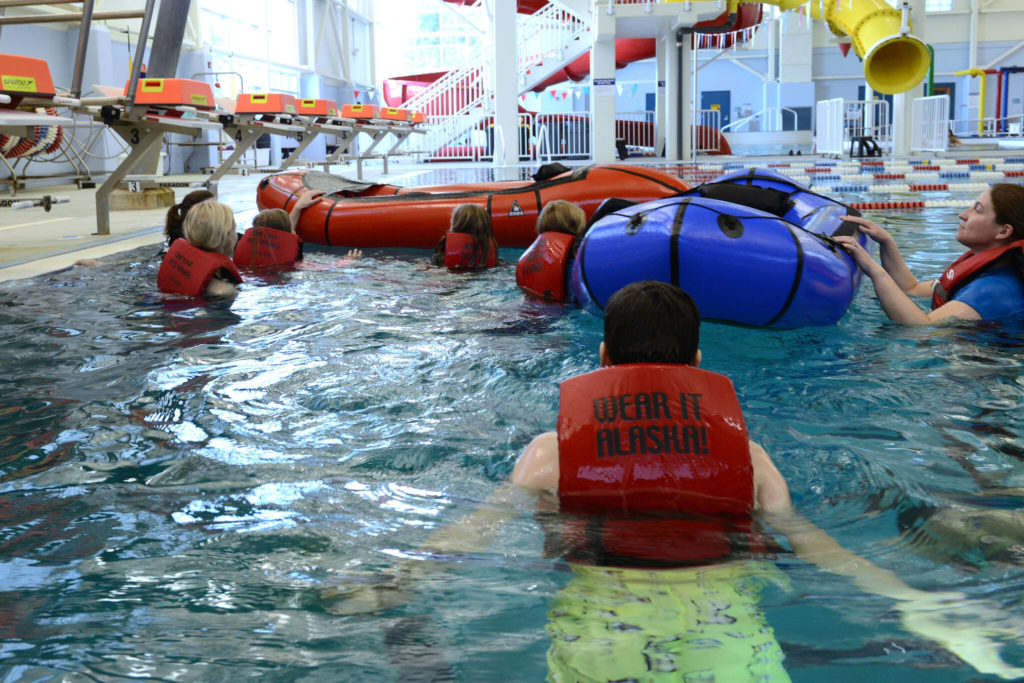Future instructors from the Goldbelt Heritage Foundation, Xheighaa Warrior Veteran Canoe Journey, Coast Guard Sector Juneau and 17th Coast Guard District took part in a Kids Don’t Float training session to be held at the center Dimond Park Aquatic in Juneau, Alaska, April 13, 2022. (US Coast Guard / Petty Officer 2nd Class Lexie Preston)
Coast Guard volunteers, alongside trainers from the Goldbelt Heritage Foundation and Xheighaa Warrior Veteran Canoe Journey, spent training Wednesday morning teaching Alaskan children boating safety lessons.
The program, which began in its most basic form with District 17 in the late 1990s, is a strong child safety training program in the state with the most coasts in the nation, said specialist Mike Folkerts. boating safety D17.
“We run a Kids Don’t Float training program,” Folkerts said in a phone interview. “We train instructors to train children to go out in boats safely.”
Eleven trainers, including four from partner organizations, spent the morning at the Dimond Park Aquatic Center learning how to teach children boating safety.
“We brought the children in so that the trainee instructors had a chance to work with the children as part of their qualification to teach,” Folkerts said. “That will be their student base when they go to teach. We want to make sure they can relate to the kids and get along while getting the content across.
That knowledge is extremely important in the unforgiving seas of Alaska, said Sen. Roger Holland, R-Anchorage, a longtime Coast Guard Reserve member and supporter of the Kids Don’t Float program.
“I’m a big fan of Kids Don’t Float. It’s a great program. It’s documented to have saved about 38 lives across Alaska since it was launched and that’s just the one we know of,” Holland said in a phone interview. “It’s weird to put a canoe or a small boat in a swimming pool. It’s fun for the kids, they love it. There’s a lot of real hands-on education going on with the hands, the poolside part.
The trainers, now qualified, are able to lead boating safety lessons for children in the community, Folkerts said, with partner organizations extending that knowledge even further.
“Our goal is to inspire as many people as possible to be passionate about teaching boating safety,” Folkerts said. “That kind of diversity in your instructor base is going to reach more people than one group ever could. Partnerships are the key.
Teaching children good safety habits, such as wearing life jackets at all times on the water, is better for encouraging safety than enforcement efforts, Folkerts said.
“Kids love it. They get the full attention of the instructors and can get in the water and play. That’s how we teach kids, how we do something fun. They learn it, they remember it,” Folkerts said. “They’ll make better decisions with education than with law enforcement. I can tell you to do that, but until you do, you don’t really know. Until you’re not in cold water, you don’t understand what it does to you physiologically.
Training Coast Guardsmen who could be assigned to cutters or other mobile forces has additional benefits for the program and communities, Folkerts said.
“On the coastguard side, it also gives the possibility of multi-missions. If we send a cutter to Angoon, for example, we can also organize a boating safety course,” Folkerts said. “Every time we don’t have to pick someone up because they ran away, it saves taxpayers money. It’s expensive to send a helicopter. It doesn’t cost much to have a boating safety course.
Classes have four stations, including trying on life jackets, putting on life jackets while already submerged, a man overboard station and recovering on a small vessel after capsizing, Folkerts said. All of this is crucial in Southeast Alaska’s maritime economy.
“In Southeast Alaska, there are three people for every boat. This is the highest number of boat owners per capita in the country. In Southeast Alaska, if you’re not in a boat once a year, you’re the anomaly,” Folkerts said. “We are one of the last states to not have any form of mandatory nautical education. Ours is willful but very, very strong. We have some of the highest lifejacket wear rates in the country. We are three times the national average. We are doing a good job with education, we just need to do a little better.
The Coast Guard’s mission to rescue those in distress after the disaster is critical, Folkerts said. But how often does the call need to be made in the first place because those involved had safe browsing habits ingrained in their daily lives, Holland asked.
“It’s Alaska’s biggest lifesaving secret,” Holland said. “Our boater fatalities are higher than anywhere else in the country. It’s a dangerous place, Alaska. I believe the Kids Don’t Float program saves lives. Hopefully we can expand it to the Lower 48 and Hawaii.
• Contact reporter Michael S. Lockett at 757-621-1197 or [email protected].


